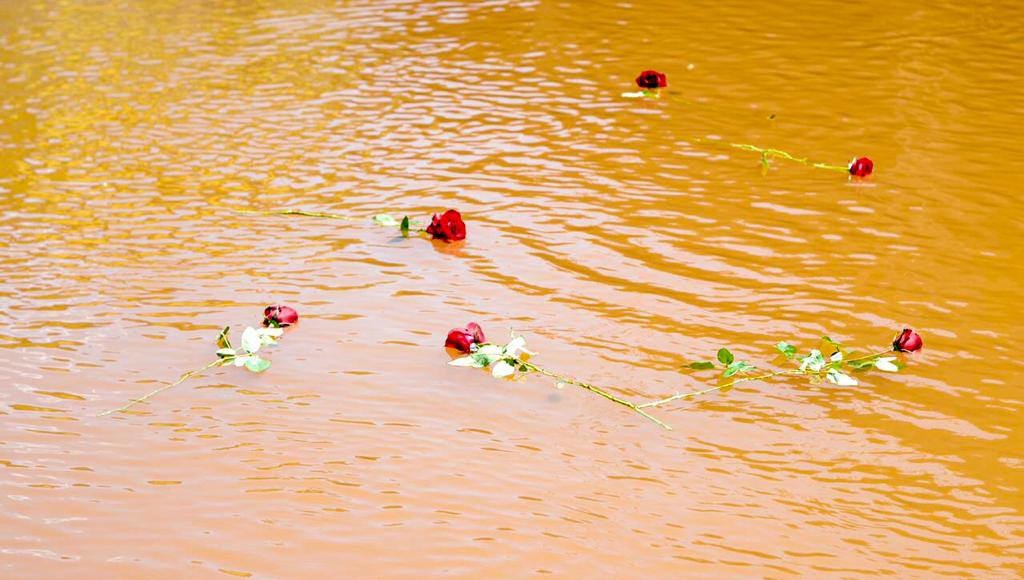Over 600 km from where the Fundão mining tailings dam collapsed five years ago, residents of the coastal region of Espírito Santo are still feeling the effects.
‘Water for Life, Not for Death!’ proclaimed members of MAB, the Movement of People Affected by Dams, in an impassioned open letter to Samarco, Vale and BHP, the three mining companies responsible for the Fundão dam collapse of November 2015. MAB is a people-led social justice movement which defends the rights of people impacted by dams – not only mine tailing dams like Fundão, but also hydroelectric projects in the Amazon region and elsewhere.
On 5 November 2020, to mark the five-year anniversary of the dam collapse, campaigners from MAB, along with hundreds of fishers, traders, surfers, indigenous people and riverine communities gathered in Regência, a coastal town in Espírito Santo, to remember those affected by the dam collapse and demand that justice be served. Those in attendance stretched out large strips of fabric on the beach that seen from above read ‘Five years of injustice!’.
The Fundão dam failure had an obvious environmental impact, with the degradation to the river system and coastal zone affecting water quality, fresh and saltwater organisms and ecosystems. But there have also been severe social, economic and cultural effects, with disruption to water supply, loss of cultural heritage and loss of livelihoods.
In the short term, all 40 municipalities running along the Rio Doce to the Atlantic Ocean lost access to clean water, fishing resources, crop production and the raw materials that support local economies. Nonetheless, the long-term effects of the disaster five years on from the spill have been even more damaging and far-reaching than was expected.
For those that used to swim, bathe and fish in the river, the Rio Doce (which translates as ‘sweet river’ in English) is sweet no more.
Loss of biodiversity
The state of Espírito Santo has 411 km of Atlantic coastline that meets the mouth of the Rio Doce. Despite their distance from the dam collapse, municipalities at the mouth of the river and adjacent coastal zones are facing chronic long-term effects that continue to put communities and ecosystems at risk.
Every rainy season, the mud is brought up from the riverbed and carried along the river, spreading on its banks and all along the coast. While the water closest to the dam collapse is gradually clearing, the mining waste washes up anew on the shores of Espírito Santo with each heavy rainfall. As a result, biodiversity at the mouth of the river and along the nearby coastline remains in serious danger.
The spread of metal-waste pollution in these coastal regions can be seen clearly in aerial images, while studies have reported elevated levels of iron, arsenic, cadmium, lead and other metals present in the seawater. This has caused huge algal blooms which, along with the mud, block sunlight from reaching undersea marine life. This prevents photosynthesis from occurring in marine vegetation and endangers the life cycle of coral. The critically endangered leatherback turtle, which nests in the Comboios nature reserve along the southern Espírito Santo coastline, is also at risk.
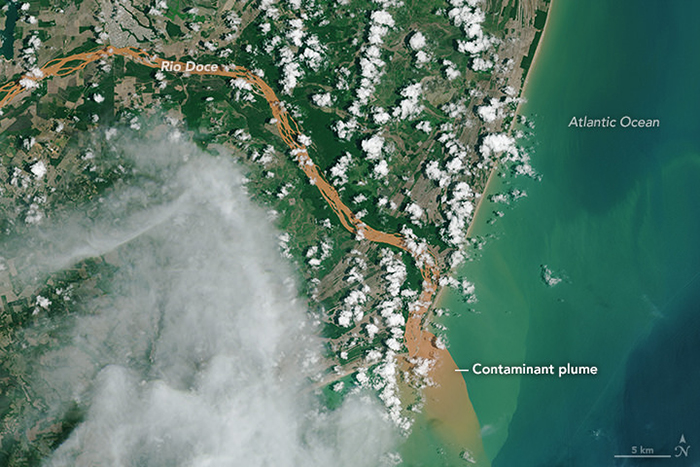
This loss of biodiversity does not bode well for a region that, according to a recent IUCN report, is particularly vulnerable to climate change. Prior to the dam failure, Espírito Santo had been experiencing a drought, meaning the Rio Doce already had reduced water levels before the dam collapse. This may have prevented the river from fully dispersing the toxic matter.
And as a result of climate change, the Rio Doce basin is forecast to have a lower average rainfall, but heavier individual rainstorms. These more frequent bouts of heavy rainfall in the coastal regions will continue to dislocate sediment from the dam collapse, leading to its release into estuarine areas, mangroves and beaches. Such environments are irreplaceable ecosystems key to the protection of coastal communities from sea level rise and extreme climate events. In a vicious circle, damage to these ecosystems is likely to make the coastal region of Espírito Santo yet more vulnerable.
Still fighting for restitution
In the months after the dam spill, the Espírito Santo government imposed a fishing ban at the mouth of the river, between Barra do Riacho and Degredo. This was both for the health and safety of the surrounding residents, and to allow fish populations to recover. At the time of writing – five years since it was introduced – the ban is still in place. In this region, where commercial artisanal fishing and beach-related tourism used to thrive, the communities of Regência, Povoação, and other coastal villages have all but lost their livelihoods and main source of income.
In the wake of the disaster, Samarco, the mine operator, and its parent companies BHP and Vale, set up the Renova Foundation in an agreement with the Brazilian state. Renova’s stated mission is to mitigate, compensate and remediate the environmental and socio-economic effects of the dam collapse. However, given that it was created and remains controlled by the same companies responsible for the dam collapse, it had a blatant conflict of interest inbuilt from the very beginning, and has failed to fulfil its mandate in a number of ways.
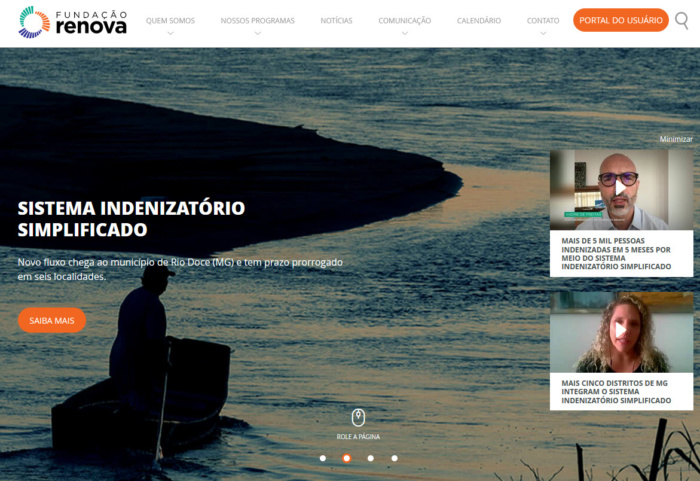
Renova has registered approximately 11,000 families in Espírito Santo eligible for compensation as a result of the fishing ban. However, the number of people who rely on fishing for food and revenue is estimated to be much higher.
A monthly financial aid card of R$1,000 – 2,000 is paid to the fishermen as compensation for the fishing ban. For many, however, this is not enough to live on and they continue to fish, in spite of the health risks this poses. Others have been forced to seek alternative employment. And for those who have become financially dependent on these grants, the omnipresent threat of a sudden cut-off looms.
Just last year, on June 29, known as Fishermen’s Day in Regência, and with the Covid-19 pandemic devastating Brazil, Renova informed around 7,000 residents of the Rio Doce basin that they would no longer receive the financial aid, arguing that they were able to return to their normal productive activities. Public defenders intervened swiftly to block the suspension and a federal court agreed, ordering Renova to reinstate the payments. Meanwhile, in a separate case, the courts threw out a request from Renova to lift the fishing ban, thus reinforcing the need for the aid payments to continue.
Then there is the issue of recognition. Their distance from the dam collapse means that a number of communities in Espírito Santo have had to fight tirelessly to be recognised by Renova as having been affected. Municipalities such as Serra and Conceição da Barra were not included in the initial compensation agreement and were only legally recognised as affected in March 2017, after a struggle lasting more than a year.
Three years later, however, Renova is once again questioning whether these communities are entitled to the same rights as those recognised in the initial agreement, arguing that until Renova’s own survey of the environmental and socio-economic impact of these municipalities has been completed, these communities should not have the right to technical assistance granted to other affected communities.
This was a key provision of the agreement made following the dam collapse, ensuring communities received independent support and advice from professionals in various fields to help them get back on their feet. These services – ranging from legal advice, to support for recovering former economic activities, to liaison with healthcare services – are free of charge to those affected, with all costs being covered by Renova.
Communities ruptured
But for many residents of the river mouth area, the river not only represents an economy but a way of life. LAB spoke with Carlos Sangalia, a Linhares resident who has participated in Renova’s advisory board as a representative of the Rio Doce River Basin Committee since its creation. ‘There has been a great rupture in the social fabric of communities on the river, particularly amongst indigenous communities and quilombos [Afro-Brazilian communities founded originally by escaped slaves],’ he says. ‘Changes in modus vivendi, cultural traditions, day-to-day routines have caused social disorder.’
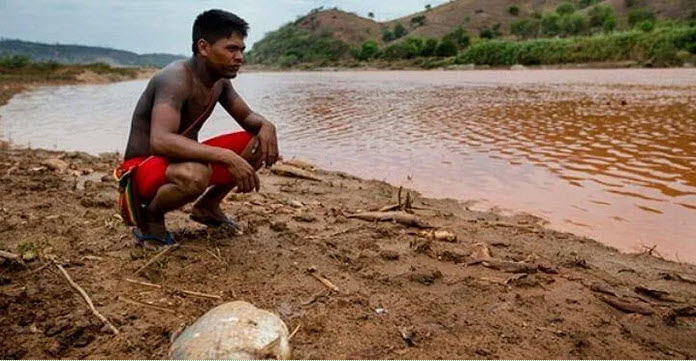
For the Tupiniquim and Guarani people, who reside in coastal regions just south of the mouth of the Rio Doce, connection with the water goes beyond the supply of water and fish. They use it to swim, bathe and find traditional medicinal herbs. For the Krenak people, who live further upstream, the river was sacred, an integral part of their way of life. It was on the banks of the river that they performed their rituals and held their parties, baptised their children, and gathered herbs for medicine and material for handicrafts. Since the dam failure, they consider that the Rio Doce is dead. With this death came the loss of their cultural heritage.
Sangalia notes that in many villages, such as Regência, rates of mental illness have increased, as have drug and alcohol dependency. Interest in local cultural traditions – such as the Congo, a traditional combination of dance, music and folklore brought to Brazil by slaves in the colonial period – has also decreased. Each year in Regência, residents and Congo bands gather to pay homage to their patron, Saint Benedict, and Caboclo Bernardo, a fisherman who threw himself into the sea in 1877 to save sailors from a shipwreck. But since the disaster, participation has declined.
‘There has been a great rupture in the social fabric of communities on the river, particularly amongst indigenous communities and quilombos. Changes in modus vivendi, cultural traditions, day-to-day routines have caused social disorder.’
How many more dams need to break?
As mining activity is set to resume at the complex where the dam burst five years ago, residents in the Rio Doce watershed fear that the companies involved have not learned any lessons. It is not by chance that the Fundão dam collapse was followed by the disaster at the Córrego do Feijão mine near Brumadinho – also in Minas Gerais, and also owned by Vale – barely three years later, and where over 270 people were killed.
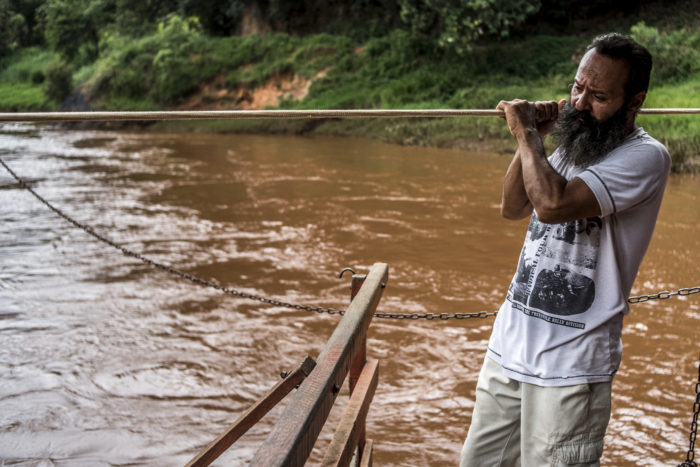
Widespread protests and forums up and down the river and coastal region illustrate that the social, economic and cultural suffering of the people of the Rio Doce basin is ongoing. As Sangalia says, ‘all along the river, people feel wronged, and this will not go away.’
Organisations such as MAB are campaigning for better standards and regulations for these types of tailings dams, arguing that the impunity for those responsible for the 2015 disaster is fuelling other dangerous mining activity in Brazil.
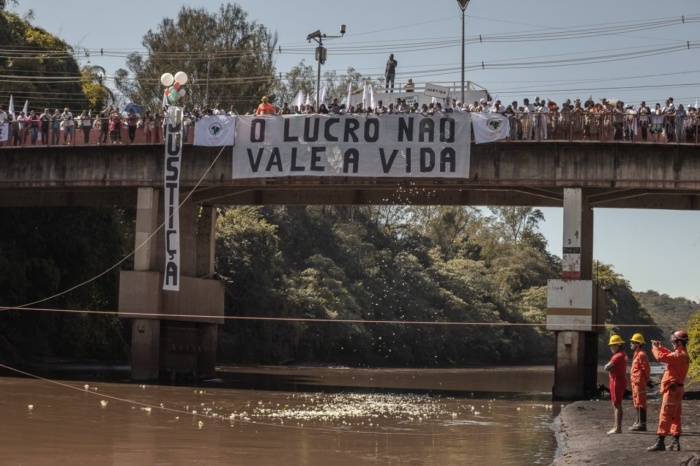
There are 87 upstream tailing dams in Brazil, most of which are in Minas Gerais, built using the same method as those that collapsed in Mariana and Brumadinho. Of these 87, it is estimated that 27 other dams are potentially unsafe, and that over 100,000 Brazilians live downhill from a dam in danger of collapsing.
In the words of Friar Galvinder Moreira, a Carmelite priest with a long history of activism with social movements in Minas Gerais, ‘How many dams still need to break and how many more crimes will happen for the authorities to hear the cries of the people, mother earth, sister water and all living beings?’
Jasmine Haniff is a student at Goldsmiths College, London. As part of her course, she is working with LAB on a series of articles about the impact of mining on bodies of water and their surrounding communities.
See her earlier article here.
Main image: Ninja Media / MAB

